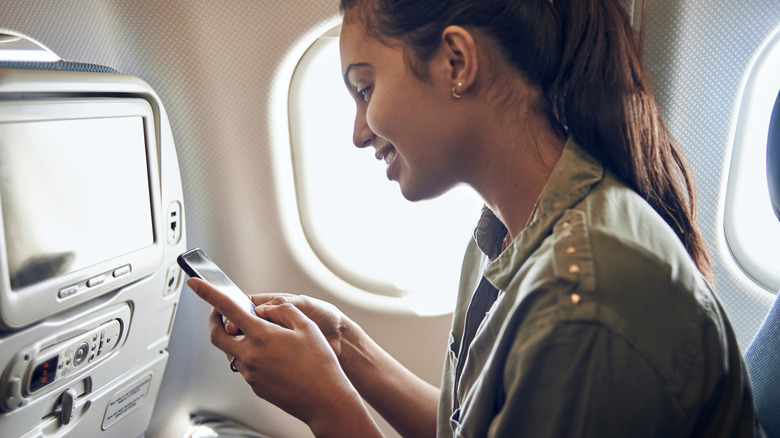How Do Airplanes Offer Wi-Fi In The Sky?
It's one of those marvels of the modern world: we can be cruising along in a plane that's 35,000 feet above the ground and still be able to scroll through social media and send emails thanks to in-flight Wi-Fi. Since almost all of us can remember a time when accessing the internet on an airplane was nothing more than a pipe dream, in-flight Wi-Fi can feel like magic. But it turns out there's nothing magical about how it works. In-flight Wi-Fi is actually a result of sophisticated technology that connects planes to the internet using a mix of antennas, ground stations, and satellites.
Several U.S. airlines offer Wi-Fi at different price points, and if you've ever logged on during a flight, you know the performance isn't always perfect. You may have experienced slow speeds or connection drops during flight, especially if the airline is using an older system. However, that's beginning to change as airlines upgrade to newer, faster options, including satellite systems that come with higher speeds and more reliable service, even on long-haul flights.
Today's airline Wi-Fi supports messaging, web browsing, and sometimes even streaming. The only catch is, it's a shared connection among dozens, possibly hundreds, of passengers, which can slow things down when a lot of passengers are online. How fast the Wi-Fi is on a plane will ultimately come down to what type of connection it's using. Most planes connect to the internet in one of two ways: air-to-ground (ATG) systems that link to cell towers on the ground, or satellite-based systems that communicate with orbiting satellites.
How air-to-ground (ATG) systems connect planes to the internet
ATG systems work a lot like the cellphone service you use to stay connected on the ground, just on a much larger and more powerful scale. A plane that's equipped with an ATG system has antennas mounted on the underside of the aircraft that connect to ground-based cell towers. As the plane flies overhead, these towers send signals directly to it, creating a kind of airborne cellular network. After the plane picks up the signal, it's sent to a server inside the cabin and broadcast throughout the plane using onboard Wi-Fi routers. One of the biggest selling points of ATG systems from an airline's perspective is that they're relatively inexpensive to install and maintain. However, they do have a major drawback: their coverage is limited to areas with ground-based towers, which means ATG Wi-Fi only works well on domestic flights over populated regions.
Once a plane is over the ocean, crossing a desert, or flying in a remote mountainous area, there's a good chance it'll lose connectivity because there are no towers in range, just like what happens with your cell phone. This sometimes spotty coverage might make you wonder if in-flight Wi-Fi is worth the cost, or if it makes more sense to wait until you're back on the ground to reconnect. If the plane you're flying has an ATG system, its connection speed will generally max out around 5 Mbps, enough for you to send texts, check emails, and browse the web, but not much more, especially if multiple people are connected at the same time.
How satellite-based Wi-Fi beams internet from space
If you're on a plane using satellite-based Wi-Fi, the aircraft connects to the internet via geostationary orbit or low-Earth-orbit satellites. While ATG antennas are mounted on the bottom of an aircraft, those used for satellite connections are usually installed on the top of the fuselage, which allows them to establish a direct connection with satellites positioned high above the Earth. These satellites then relay the signal to ground stations, which communicate with land-based networks and send data back up to the aircraft to keep you connected during your flight.
There are two primary types of satellite bands used for in-flight Wi-Fi: Ku-band and Ka-band. Depending on the equipment and satellite service, a Ku-band system delivers speeds that typically range from 25 to 50 Mbps, which is enough for regular browsing and streaming, especially when there aren't many passengers online. Ka-band systems are faster, with more stable connections, and can reach speeds of up to 70 Mbps. If you're flying on a plane with a Ka-band system, you'll be able to watch videos and share content on social media in real time. With American Airlines preparing to offer free in-flight Wi-Fi and other carriers already doing so, it's almost certain that demand will continue to grow. To keep up, airlines will likely be looking for ways to upgrade their systems to provide the most reliable Wi-Fi connections possible.


